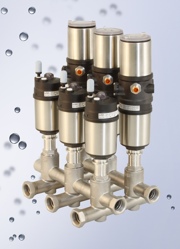The latest generation of innovative INOX valve bodies from Bürkert can eliminate the need for a large number of pipe sections, bends and connections in complex interfaces. Removing a collection of conventional piping greatly reduces space requirements, speeds-up design and installation time and reduces the opportunities for leaks.
Combining fluid, distribution or mixing flows by means of valves is one of the essential, basic processes in production systems for just about every industrial sector. The piping or fluid connections of the various valves and sensors generally involve extensive planning and installation. This obviously increases with the number of valves used in the system.
In the classic scenario, valves and sensors are joined by means of piping components that are connected using conventional connecting technology, such as threaded, flanged, adhesive or welded connections. The disadvantages of such connections include high installation expense and extensive space requirements for the piping.
Fluid connections for valves and sensors in the process industry therefore constantly provide a challenge for system designers, pipe constructors and installers; to implement a piping system that is as simple as possible, while being quick to install and free of leaks. In addition, the solution has to be cost-effective and should require minimal installation space.
The solution
The innovative INOX modular valve body eliminates the need for conventional pipeline connections between single valves and with some sensors. The fluid connections are established by direct joining of the valve bodies. This allows complex multilayered and multiport flow paths to be established using a simple to construct modular valve body arrangement and conventional valve heads.
The INOX DN10 size valve and new larger DN20 designs offer plant and process engineers a simple and fast implementation for extremely compact and robust valve systems with high functional reliability. The modular design of the valve bodies in both designs also enables the cost-effective production of small quantities.

Valve system eliminates pipe joins and bends
The DN10 version accepts Bürkert's INOX 2000 series stainless steel bodied valve actuator heads and simply bolts together to form a block with seals and short connection rings compressed together to form a high-integrity seal. Ports can be machined out and opened-up for inlets, outlets and sensors for temperature etc. depending on requirements.
The DN20 version, which accepts Burkert's popular element valve series, offers a huge range of options from a similar concept, the valve body offers a four way cross-flow arrangement and can be supplied pre-welded in multiple arrangements. The valve actuator orifices are spaced slightly wider to accommodate the larger Element actuation heads, so the valve bodies are supplied together rather than being bolt-together items like the DN10 version.
During installation there is far less requirement to bend and cut pipes to length, fewer screwed connections and fewer 90˚ elbow or T joints used. Besides saving time and material requirements for the installation, the new designs provide a greatly reduced risk of leaking connections, especially in a system with alternating temperatures.
The separation of the inlet and outlet levels in the new valve bodies also makes it possible to optimise the Kv value, due to reduced redirection of fluid flow in comparison with conventional valves, making the system more efficient.
The target groups for the new valve body concept are OEMs, plant engineers and integrators, who only have limited installation space available for fluid function solutions. The significantly reduced piping requirements save not only space, but also costs for extensive planning and installation, as well as materials. Fewer pipe connections also mean fewer potential weak points and increased functional reliability due to a lower risk of leaks.




